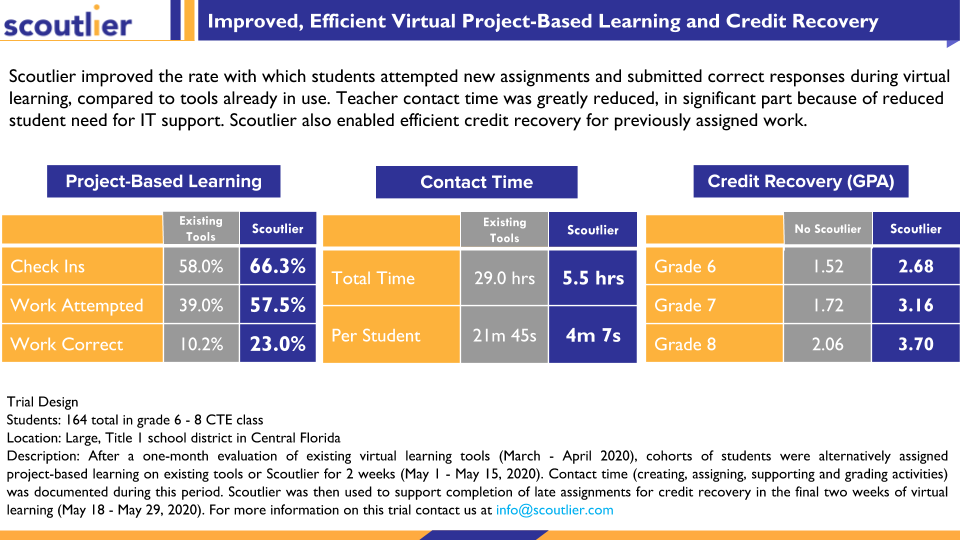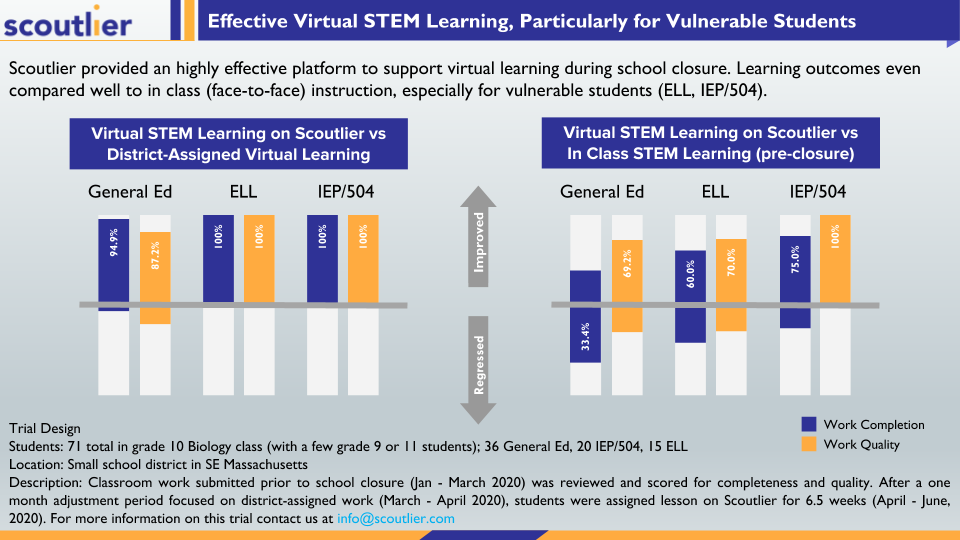CASE STUDIES
Improved, Efficient Virtual Learning and Credit Recovery
SUMMARY
Scoutlier improved the rate with which students attempted new assignments and submitted correct responses during virtual learning, compared to tools already in use. Teacher contact time was greatly reduced, in significant part because of reduced student need for IT support. Scoutlier also enabled efficient credit recovery for previously assigned work.
TRIAL DESIGN
Students: 164 total in grades 6-8 CTE class
Location: Large, Title 1 school district in Central Florida
Description: After a one-month evaluation of existing virtual learning tools (March-April 2020), cohorts of students were alternatively assigned project-based learning on existing tools (Edsby and Office 365) or Scoutlier during a 2 week period (May 1 – May 15, 2020). Contact time (creating, assigning, supporting, and grading activities) was documented during this period. Scoutlier was then used to support the completion of late assignments for credit recovery in the final two weeks of virtual learning (May 18 – May 29, 2020).
RESULTS
Project-Based Learning
For each activity assigned virtually, using existing classroom tools for half of the students, and Scoutlier for the other half, the rate at which students logged into the system (“checked in”) and initiated work (“work attempted”) was measured. Both rose when activities were assigned on Scoutlier, with “check-ins” increasing from 58.0% to 66.3% and “work attempted” increasing from 39.0% to 57.5%. The frequency with which students successfully completed their activity (“work correct”) also rose, from 10.2% to 23.0%, when work was done on Scoutlier.
Contact Time
The time required to create, assign, support students, and organize & grade work was measured for activities delivered virtually on existing classroom tools and Scoutlier. Creating and assigning activities on Scoutlier using its authoring tool and embedded templates took 30 minutes, no time was required to organize student work products as this is automated on the platform, and on average it took 60 minutes/assignment to grade. Students required limited support to work through the activities, resulting in a total of 5.5 hours of contact time (4m 7s per student) for activities assigned on Scoutlier during the trial. Creating assignments on existing classroom tools, including assessment templates and instructions / instructional materials, took 1.5 hours or more to develop. Assessment templates were created on Office 365 and then shared on to the grading platform with the instructional materials. Often video instructions were needed to allow students to make progress. Students required significant support and time (15 hours) on how to use this system. Organizing student work was time-consuming, taking over 4 hours, resulting in 29 hours of total contact time (21m 45s per student) for activities assigned on existing tools.
Credit Recovery
At the conclusion of the trial, coinciding with the final two weeks of the school year, no new work was assigned. Instead, students were given an opportunity to complete outstanding work and improve their GPA. Initially, this was performed using existing classroom tools, resulting in a modest uptick in average GPA. During the final week, key assignments were also delivered on Scoutlier, supporting an increase in GPA from 1.52 to 2.68 for Grade 6 students; 1.72 to 3.16 for Grade 7 students; and 2.06 to 3.70 for Grade 8 students.
For more information on this trial contact us at info@scoutlier.com
SELECTED SCOUTLIER ACTIVITIES FROM TRIAL
Effective Virtual STEM Learning, Particularly for Vulnerable Students
SUMMARY
Scoutlier provided a highly effective platform to support virtual high school STEM learning during school closure. Learning outcomes compared well to traditional, classroom instruction, especially for vulnerable students (ELL, IEP/504). We believe this results in part from students being able to respond and create products using different modes (text, data, audio, video) within a single platform.
TRIAL DESIGN
Students: 71 total in grade 10 Biology class (with a few grade 9 or 11 students); 36 General Ed, 20 IEP/504, 15 ELL
Location: Small school district in SE Massachusetts
Description: Classroom work submitted prior to school closure (Jan – March 2020) was reviewed and scored for completeness and quality. After a one month adjustment period focused on district-assigned work (March – April 2020), students were assigned lessons on Scoutlier for 6.5 weeks (April – June 2020).
RESULTS
All student work products created during the trial were evaluated on the following scales for Completeness: 0 – not done; 1 – some; 2 – most/ complete but late; 3 – complete and on time, and Quality: 1 – partial answer and / or mostly inaccurate; 2 – mostly accurate, mostly complete – met expectations; 3 – mostly accurate, thorough answers, good presentation – exceed expectation (only for work that received a score of 2 or more for Completeness).
Virtual Learning on Scoutlier vs District-Assigned Work
During a 6-week period immediately following school closure, students were assigned work at the district level. The following 6-weeks they were assigned a weekly activity by their teacher on Scoutlier. Within the general education population, the completeness and quality scores with Scoutlier rose for 94.9% and 87.2% of students, respectively. Amongst the ELL students and those on IEPs/504s, every student (100%) showed an increase in work completeness and quality with Scoutlier. These results indicate that Scoutlier effectively supported virtual learning, particularly for vulnerable students.
Virtual Learning on Scoutlier vs In Class STEM Learning (pre-closure)
Given the success observed with Scoutlier during virtual learning, students’ performance supported by this platform during closure was compared to their performance pre-closure, when they received traditional in classroom instruction. Within the general education population, the completeness and quality scores with Scoutlier rose for 33.4% and 69.2% of students, respectively, with Scoutlier. Amongst the ELL students, completeness and quality scores with Scoutlier rose for 60.0% and 70.0% of students, respectively. Finally, amongst students on IEPs/504s completeness and quality scores with Scoutlier rose for 75.0% and 100% of students, respectively. These results suggest that virtual learning on Scoutlier resulted in learning outcomes that were comparable to those obtained with traditional, in classroom instruction, and may even have improved outcomes for vulnerable students.
For more information on this trial contact us at info@scoutlier.com

